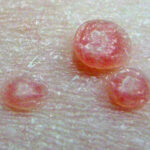Key Facts
- Molluscum contagiosum is a benign (not dangerous) bumpy skin infection caused by a virus.
- Molluscum contagiosum is spread from person to person during contact sports, sex, or sharing towels with someone who has it.
- Do NOT scratch or pick at the bumps. See your health care provider.

Molluscum contagiosum is a common skin infection caused by a virus. It’s annoying, but not dangerous. Anyone can get it, but it’s most common among children who are 1-10 years old, people who are sexually active, and people who have trouble fighting off infection.
How is molluscum contagiosum spread?
Molluscum contagiosum is passed from one area of the body to another by scratching and from one person to another by direct skin-to-skin contact with an infected person’s bumps or by having contact with an object that has the virus on it. It’s important not to itch or scratch at the bumps to prevent further spread and prevent secondary bacterial infection. The virus is spread
- During any type of skin to skin contact such as sexual activity, contact sports, or other activity that involves touching the bumps of an infected person.
- Through contact with a towel, washcloth, bed sheets, clothing or something else that has the virus on it.
- To other parts of an infected person’s body by scratching the bumps.
What are the symptoms of molluscum contagiosum?
Molluscum contagiosum first appears as very small (about 1/8 inch across), smooth, round, pearly bumps. The bumps are hard with a dimple in the middle. They are the color of your flesh, pink, or white, and they are usually no bigger than the size of a pencil eraser. You may see them on or around the pubic area, on the stomach, or inner thighs or anywhere on the body except the palms of your hands or the bottom of your feet. There may be one or two bumps or 10 to 20 or more than 50. Most people have a small group of bumps. The bumps are usually not painful or itchy but they can become red, swollen, uncomfortable and even itchy if they become infected. However, redness and soreness can also mean that they are healing naturally.
Most often the bumps resolve on their own without scarring. However, the most common complication is secondary infection by bacteria. These secondary infections can be particularly problematic for people who are immunocompromised, such as people who have HIV/AIDS or cancer.
When do the bumps appear?
The symptoms of molluscum contagiosum usually appear within 2-6 weeks after coming in contact with the virus.
How is molluscum contagiosum diagnosed?
The molluscum contagiosum bumps or rash can look like other skin conditions. Therefore, if you have symptoms, you should make an appointment with your health care provider, who can look at the bumps and make a diagnosis.
How is molluscum contagiosum treated?
Molluscum contagiosum bumps will usually go away on their own, but it may take several months. Treatment shortens how long you have them. If you have bumps on or near your genital area including your vagina, vulva, inner thighs, buttocks, anus and you’re sexually active; you may want to be treated to help prevent spreading the virus to your sexual partner(s). Side effects of treatment may include: pain, irritation and possible scarring.
Treatment options include:
- Freezing the bumps (cryotherapy) or laser therapy by a health care provider
- Scraping the bumps (curettage) a health care provider uses a small tool called a “curette” to scrape the bumps. Never do this yourself as you can cause scarring.
- Special cream or liquid prescribed or applied by a health care provider, is applied directly to the bumps.
Is there anything I can do to prevent others from coming in contact with my skin (bumps)?
Yes. It’s important to keep the bumps clean and covered with either a watertight bandage or with clothing if you know you’ll be coming in contact with others (during contact sports or sharing equipment). This will lower the chance of spreading the molluscum infection to others. Remember: Don’t share personal items such as towels and clothing, be careful not to shave near the bump(s), and don’t pick or scratch them, and avoid swimming in a pool with others while the bumps are present. You may uncover the bandage(s) when there is no risk you will have skin to skin contact with others.
Our health guides are developed through a systematic, rigorous process to ensure accuracy, reliability, and trustworthiness. Written and reviewed by experienced healthcare clinicians from Boston Children's Hospital, a Harvard Medical School teaching hospital and consistently ranked as a top hospital by Newsweek and U.S. News & World Report, these guides combine clinical expertise, specialized knowledge, and evidence-based medicine. We also incorporate research and best practices from authoritative sources such as the CDC, NIH, PubMed, top medical journals, and UpToDate.com. Clinical specialists and subject matter experts review and edit each guide, reinforcing our commitment to high-quality, factual, scientifically accurate health information for young people.

